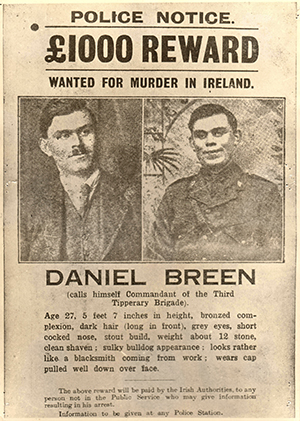Dan Breen’s ‘wanted’ poster
Published in Artefacts, Issue 3 (May/June 2021), Volume 29By Cian Flaherty

(Kilmainham Gaol Museum)
For IRA men on the run during the War of Independence, photographs of them were dangerous objects, liable to be seized by the authorities and printed in the Hue-and-Cry and on ‘wanted’ posters, such as this one for Dan Breen of the 3rd Tipperary Brigade, printed by Alex Thom & Co. in November 1920.
The photograph on the right, of Breen in the uniform of the Irish Volunteers, is by Joseph Wynne of Tipperary town. It was probably taken in late October 1918 on the occasion of the funeral of a prominent Sinn Féin activist, Thomas Hogan of Roesboro, who died of the ‘Spanish ’flu’. Hogan’s coffin was guarded in St Michael’s Church, Tipperary, by a party of six Volunteers, possibly including Breen.
Three months later, on 21 January 1919, Breen and other members of the 3rd Tipperary Brigade captured a cartload of gelignite at Soloheadbeg, killing two RIC constables, James McDonnell and Patrick O’Connell, in the process. Breen and his comrades were soon among the most wanted men in Ireland. The physical effect of life ‘on the run’ is evident in the second photograph, probably taken in spring 1920: Breen looks much leaner and older. The original image, by Keogh Bros. of Dublin, includes Séumas Robinson and Seán Treacy, both also of the 3rd Tipperary Brigade, and Michael Brennan of the East Clare Brigade. The sitters knew the risk of being photographed. Perhaps they intended it to serve as a keepsake if they were killed. Indeed, Seán Treacy was killed later that year, and this is the only extant photograph of him as an adult.
According to the poster, Breen ‘calls himself Commandant of the Third Tipperary Brigade’. In fact, Breen never held this position. When the brigade was formed in October 1918, Séumas Robinson was elected commandant, and retained this position until he was promoted to command of the IRA’s 2nd Southern Division in late 1921. Breen was brigade quartermaster. Robinson suspected that the British did not want it known that he was in command of the brigade; it seems that Breen better suited British propaganda purposes.
Later, Breen used the poster to his advantage by reproducing it in his ghostwritten 1924 autobiography, My fight for Irish freedom, in which he also claims the rank ascribed to him on the poster. The book’s success—a second edition appeared a mere month after the first—ensured that the poster became closely associated with the War of Independence. In the book, Breen mentions that the authorities offered a £1,000 reward in the aftermath of the Soloheadbeg ambush, and the inclusion of the wanted poster in this section of the book has led to the mistaken belief that it was issued in response to Soloheadbeg. The Soloheadbeg reward, however, was for ‘such information as shall lead to the conviction of the murderers’, not Breen alone, and notices in the Hue-and-Cry show that Breen was specifically wanted for the killing of Major G.O.S. Smyth at ‘Fernside’, Drumcondra, on 12 October 1920. More conclusively, the poster is dated ‘11.20’, i.e. November 1920.
A century after its creation, the poster prompts important questions about how parties on opposing sides use documents to create and support their own narratives.
Cian Flaherty holds an MPhil. in Modern Irish History from Trinity College, Dublin.
















